Comunicación entre paciente adulto críticamente enfermo y el profesional de enfermería: una revisión integrativa
DOI:
https://doi.org/10.22235/ech.v10i1.2412Palabras clave:
comunicación en salud, enfermería, cuidados críticos, pacientesResumen
Introducción: La comunicación entre enfermero y paciente que se encuentra en unidades críticas con compromiso vital está limitada por la sedación, ventilación mecánica, y presencia de tubo endotraqueal, interfiriendo en la entrega de cuidados. Objetivo: analizar en la literatura científica publicada cómo se efectúa la comunicación entre el paciente adulto críticamente enfermo y profesionales de enfermería. Metodología: Revisión integrativa de diversas bases de datos. En el análisis crítico, 13 artículos cumplieron los criterios de inclusión. Como criterio de exclusión se consideraron los artículos desarrollados en usuarios pediátricos y otros servicios de hospitalización. Resultados: de la revisión surgieron tres temáticas, a) Métodos de comunicación paciente crítico-enfermero b) Percepción del paciente sobre la comunicación enfermero-paciente c) Factores limitantes en la comunicación enfermero- paciente crítico. Conclusiones: Se concluye que las actividades asistenciales de enfermería en estas unidades se centran casi en su totalidad en acciones biomédicas, relegando a un segundo plano aspectos emocionales. Existe una necesidad de desarrollar habilidades de comunicación para garantizar que todo enfermero que trabaja con pacientes críticamente enfermos, sean capaces de generar una comunicación efectiva con el paciente y su entorno, actuando como agentes de cambio para fortalecer el cuidado de manera holística y humanizada.
Descargas
Citas
Rivera AB, Rojas LR, Ramírez F, Álvarez de Fernández T. La comunicación como herramienta de gestión organizacional. Negotium. 2005; 1(2): 32-48. Disponible en: http://www.redalyc.org/articulo.oa?id=78212103
Kourkouta L, Papathanasiou I. Communication in Nursing Practice. Mater Sociomed. 2014; 26(1): 65-7. https://doi.org/10.5455/msm.2014.26.65-67
Cibanal LJAS, Carballal MCB. Técnicas de comunicación y relación de ayuda en ciencias de la salud. 2° ed. España: Elsevier España; 2010. p. 35-50.
Bautista Rodríguez LM, Arias Velandia MF, Carreño Leiva ZO. Percepción de los familiares de pacientes críticos hospitalizados respecto a la comunicación y apoyo emocional. Rev. Cuid. 2016; 7(2): 1297-309. Disponible en: http://www.redalyc.org/articulo.oa?id=359546229007
Landete L. La comunicación pieza clave en enfermería. Enfermería Dermatológica. 2012; 16(1): 16-9. Disponible en: https://www.anedidic.com/descargas/formacion-dermatologica/16/La-comunicacion-pieza-clave-en-enfermeria.pdf
Moreira FTLS, Callou RCM, Albuquerque GA, Oliveira R. Effective communication strategies for managing disruptive behaviors and promoting patient safety. Rev. Gaúcha Enferm. 2019; 40(spe): e20180308. http://dx.doi.org/10.1590/1983-1447.2019.20180308
Ayuso-Murillo D, Colomer-Sánchez A, Herrera-Peco I. Habilidades de comunicación en enfermeras de UCI y de hospitalización de adultos. Enfermería Intensiva. 2017; 28(3): 105-113. https://doi.org/10.1016/j.enfi.2016.10.006
Souza M, Silva M, Carvalho R. Integrative review: What is it? How to do it? Einstein. 2010; 2(1): 102-6. https://doi.org/10.1590/s1679-45082010rw1134
Peña Herrera C, Soria J. Pregunta de investigación y estrategia PICOT. Rev. Med. FCM-UCSG. 2015; 19(1): 66-9. https://doi.org/10.23878/medicina.v19i1.647
Dithole K, Thupayagale-Tshweneagae G, Oluwaseyi A, Moleki M. Communication skills intervention: promoting effective communication between nurses and mechanically ventilated patients. BMC Nursing. 2017; 16: 74. https://doi.org/10.1186/s12912-017-0268-5
Schandl A, Falk AC, Frank C. Patient participation in the intensive care unit. Intensive Crit Care Nurs. 2017; 42: 105-109. https://doi.org/10.1016/j.iccn.2017.04.006
Thakur P, Venkateshan M, Sharma R, Prakash K. Nurses Communication with Altered Level of Consciousness Patients. International journal of nursing education. 2016; 8(3): 51-56.
Dithole K, Sibanda S, Moleki MM, Thupayagale-Tshweneagae G. Exploring communication challenges between nurses and mechanically ventilated patients in the Intensive Care Unit: A structured review. Worldviews Evid Based Nurs. 2016; 13(3): 197-206. https://doi.org/10.1111/wvn.12146
Tolotti A, Bagnasco A, Catania G, Aleo G, Pagnucci N, Cadorin L, Zanini M, Rocco G, Stievano A, Carnevale FA, Sasso L. The communication experience of tracheostomy patients with nurses in the intensive care unit: A phenomenological study. Intensive Crit Care Nurs. 2018; 46: 24-31. https://doi.org/10.1016/j.iccn.2018.01.001
Sánchez-Expósito J, Leal Costa C, Díaz Agea JL, Carrillo Izquierdo MD, Jiménez Rodríguez D. Ensuring relational competency in critical care: Importance of nursing students' communication skills. Intensive Crit Care Nurs. 2018; 44:85-91. https://doi.org/10.1016/j.iccn.2017.08.010
Langlume S, Labro G, Puyraveau M, Capellier G, Piton G. Estimation of critically ill patients’ complaints by the nurse, the physician and the patient’s family: A prospective comparative study. Intensive and Critical Care Nursing. 2017; 43: 55-60. https://doi.org/10.1016/j.iccn.2017.07.002
Van Mol MM, Boeter TG, Verharen L, Kompanje EJ, Bakker J1, Nijkamp MD. Patient- and family-centred care in the intensive care unit: a challenge in the daily practice of healthcare professionals. J Clin Nurs. 2017; 26(19-20):3212-23. https://doi.org/10.1111/jocn.13669
Dithole KS, Sibanda S, Moleki MM, Thupayagale-Tshweneagae G. Nurses' communication with patients who are mechanically ventilated in intensive care: the Botswana experience. Int Nurs Rev. 2016; 63(3): 415-21. https://doi.org/10.1111/inr.12262
Rodriguez C, Rowe M, Thomas L, Shuster J, Koeppel B, Cairns P. Enhancing the Communication Process of Suddenly Speechless Patients in the Critical Care Setting. Am J Crit Care. 2016; 25(3): e40–e47. https://dx.doi.org/10.4037/ajcc2016217
Clark K, Milner K, Beck M, Mason V. Measuring Family Satisfaction with Care Delivered in the Intensive Care Unit. Crit Care Nurse. 2016; 36(6): e8-e14. https://dx.doi.org/10.4037/ccn2016276
Antonacci R, Fong A, Sumbly P, Wang Y.F, Maiden L Doucette E, Gauthier M, Chevrier A. They can gear the silence: Nursing practices on communication with patients. Canadian Journal of Critical Care Nursing, 2018; 29(4): 36-9. https://doi.org/10.4037/ajcc2011433
Gropp M, Johnson E, Bornman J, Koul R. Nurse’s perspectives about communication with patients in an intensive care setting using a communication board: A pilot study. Health SA Gesundheit 2019; 24(0): 1-9. https://doi.org/10.4102/hsag.v24i0.1162
Baker C, Melby V. An investigation into the attitudes and practices of intensive care nurses towards verbal communication with unconscious patients. J Clin Nurs. 1996; 5(3): 185–92. https://dx.doi.org/10.1111/j.1365-2702.1996.tb00248.x
Nilsen, M.L, Happ M.B, Donovan H, Barnato A, Hoffman L, Sereika S.M. Adaptation of communication interaction behaviour instrument for use in mechanically ventilated, Nonvocal Older Adults. Nurs. 2014; 63: 3–13. https://doi.org/10.1097/NNR.0000000000000012
Radtke T.V, Tate J.A, Happ M.B. Nurses perception of communication training in the ICU. Intensive and Critical Care Nursing, 2012; 28(1): 16–25. https://doi.org/10.1016/j.iccn.2011.11.005
Alegría L, Pedrero V, Fuentes I, Sanhueza MA, Toro M, Díaz P et al. Documento de Consenso Una aproximación a la práctica de enfermería basada en la evidencia en unidad de paciente crítico. Rev Chilena Medicina intensiva. 2016; 31(3): 149-61. Disponible en: https://www.medicina-intensiva.cl/reco/mbe_2016.pdf
Vílchez-Barboza V, Paravic-Klijn T, Salazar-Molina A. La escuela de pensamiento Humanbecoming: una alternativa para la práctica de la enfermería. Cienc Enferm. 2013; (2): 23-34. http://dx.doi.org/10.4067/S0717-95532013000200003
Descargas
Publicado
Cómo citar
Número
Sección
Licencia
Derechos de autor 2021 Enfermería: Cuidados Humanizados

Esta obra está bajo una licencia internacional Creative Commons Atribución 4.0.

















